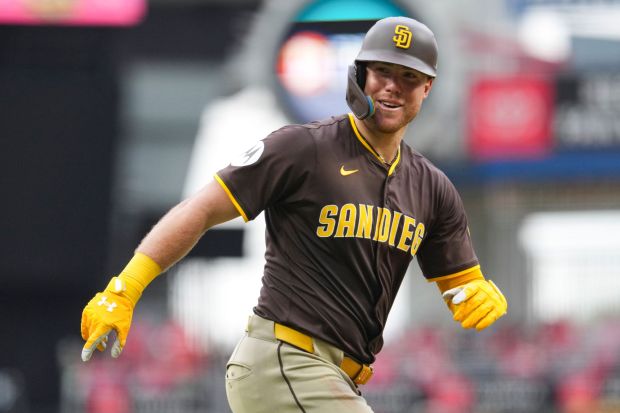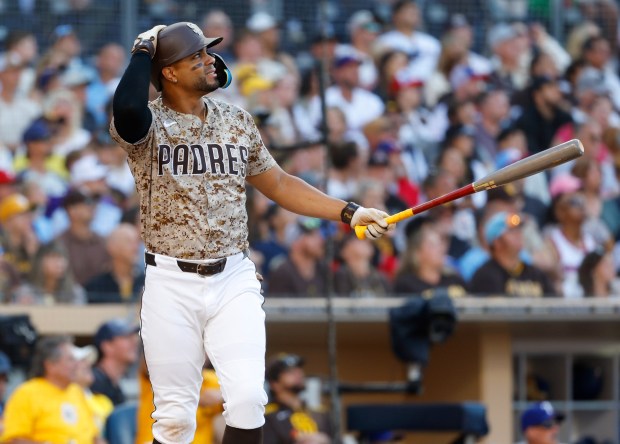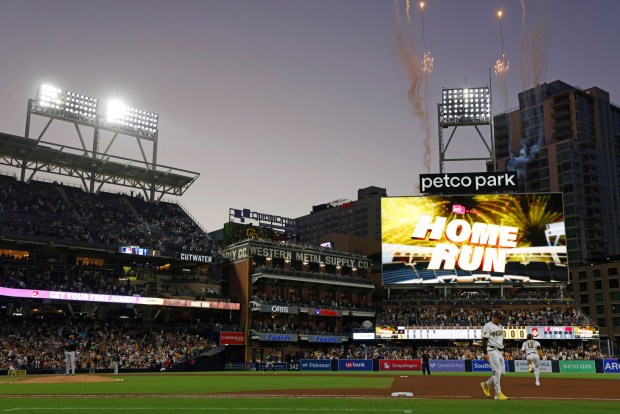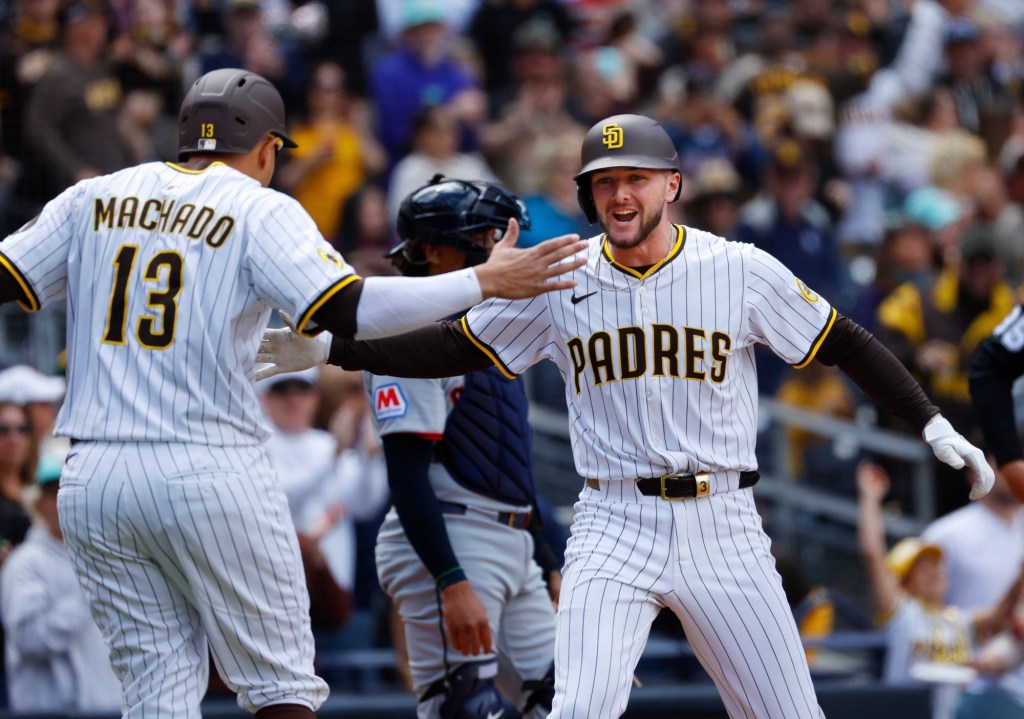WASHINGTON — It seems pretty plain to Manny Machado.
“We played our worst ball so far,” he said Tuesday night, standing in a corridor at Truist Park in Atlanta, still dressed in his uniform after playing in the All-Star game. “So the best is yet to come.”
There was too much confidence in Machado’s tone to imply that it was a matter of him simply believing it can’t get any worse.
It certainly could.
For however it might have seemed during portions of May and June, the Padres have been pretty good — at least relatively speaking.
They are eight games over .500 and in possession of the National League’s final wild-card spot.
But they know they can be better. They know they should be better. They know they have to be better.
And that applies mainly to the offense.
The Padres’ starting rotation, which just got back Yu Darvish two starts ago and expects to be whole by the middle of August with the return of Michael King, has survived despite relying on inexperienced pitchers and not getting its money’s worth from Dylan Cease. The bullpen, with the major leagues’ second-lowest ERA (3.20), has been the Padres’ backbone.
But as the Padres prepare to begin what is traditionally known as the second half — even though they’re 25 games past the midpoint of their season — there is a deep-seated concern that their backs will break if it the ‘pen continues to carry the weight.
The Padres have played a lot of close and low-scoring games.
The 35 games in which they have scored two or fewer runs is most among any team with an overall winning record. The Padres’ 11 victories in those games are second most in the majors. Winning games without scoring a lot requires good pitching and defense, and it often entails some excellent baserunning. But it is by no means a good thing to have so many games, as evidenced by their 24 losses in such games.
The Padres have had 78 games decided by one or two runs, second only to the Rockies, whose record is the worst in the major leagues.
The most such games a playoff team has had in any of the past three seasons was 118. For the Padres not to blow past that number, they would need to lower their rate of one- and two-run games from 81% to 61%.
They love to tout their ability to excel at “playoff-type baseball.” That is a reference to the type of game most often played in the postseason, in which runs can be scarce and doing the little things correctly makes a big difference.
This is Mike Shildt’s kind of baseball.
His 2019 Cardinals team, which won 90 games and advanced to the National League Championship Series, ranked 24th in runs scored while their pitching staff ranked 17th in ERA. His 2021 Cardinals team, which won 90 games and earned a wild-card playoff spot, was 20th in runs and 12th in ERA.
These are not standard rankings for playoff teams. Just five of the 36 playoff teams over the past three seasons were ranked outside the top 10 in both runs and ERA. The 2023 Marlins and 2022 Rays are the only teams in the past three seasons to make the playoffs after ranking lower than 19th in runs scored.
The ‘25 Padres are ranked 25th in runs per game and sixth in ERA.
“We’ll just continue to figure out how to win on every little single margin we can,” Shildt said recently. “… When a group together does that and is invested in that, it gives you the best opportunity to keep going when things get tougher.”
That said, the Padres manager made a pair of comments on separate occasions last week that belied his assurance that winning on the margins is enough.
One, coming at the end of a soliloquy on why the Padres are able to win low-scoring games, was a wisecrack:
“But it is legal to win 7-3 or 8-2.”
The other was just straight wisdom:
“You cannot survive trying to win one-run games.”
 The Padres’ Gavin Sheets rounds the bases after hitting a three-run homer in the seventh inning of Saturday’s victory over the Reds. (AP Photo/Jeff Dean)
The Padres’ Gavin Sheets rounds the bases after hitting a three-run homer in the seventh inning of Saturday’s victory over the Reds. (AP Photo/Jeff Dean)
The Padres’ plan
So what has to happen?
“We’ve all got to string some good at-bats together as a group,” Machado said. “So hopefully, we continue doing it as a group and bring some other guys to do it.”
Machado’s last assertion is what will occupy A.J. Preller and his lieutenants for the next two weeks. They expect to add at least one significant offensive contributor and hope to add an additional offensive upgrade. The preference for a bona fide contributor is a right-handed batter and left fielder. Given the paucity of available players who specifically fit that description, are affordable and could provide a significant upgrade, the Padres have cast a wider net.
They don’t have a lot of money to commit. Nor do they have a lot of prospects or young major leaguers to trade.
They do have confidence they can once again take a big swing.
The Padres also seek to improve the offensive production they are getting from the catcher position.
But what Machado said about the group and its swings is what everyone in the organization knows is the key to this season.
The current group of players — especially the players considered the team’s offensive core — have to produce more consistently.
Padres officials will occasionally say something about how they have already made their big moves. That is a reference to the trades and signings the team has made to add King, Cease, Xander Bogaerts and Luis Arraez and lock up Machado, Fernando Tatis Jr., Jackson Merrill and Jake Cronenworth.
And that is both the problem and the promise for the 2025 Padres. That group of hitters has, by and large, not produced at the level the Padres need it to.
Consider:
- Machado has been the Padres’ most consistent offensive performer and is batting .283 with a .914 OPS in July. He did skid through the better part of June, going .181/.574 in that month’s final 18 games. 2025 totals: .292/.350/.490, 17 homers, 22 doubles.
- Tatis is batting .340 with a .956 OPS over the past 14 games. The latter number includes a .456 on-base percentage. But he hit .205 with a .657 OPS over his previous 49 games, enduring a career-high drought of 82 at-bats without a home run during that stretch. That was after he began the season batting .342 with a 1.012 OPS through 31 games. 2025 totals: .269/.366/.451, 16 homers, two triples, 13 doubles, 21 stolen bases.
- Merrill’s season has been interrupted by a 24-game absence (hamstring) and a seven-game absence (concussion) and marked by extreme highs and lows. Sandwiched around the first stay on the injured list, he began the season batting .467 with a 1.259 OPS through his first 15 games. He was still batting .331 with a .905 OPS on June 1 but hit .186 with a .516 OPS in his next 30 games before hitting two home runs and walking twice in the penultimate game of the first half. 2025 totals: .263/.328/.416, seven homers, two triples, 12 doubles.
- Arraez is a walking contradiction. He is tied for the major league lead with 13 games of three or more hits this season. Yet he is batting just .279, 27 points off his previous career low 90 games into a season. His .314 on-base percentage is 28 points lower than his previous low at this point in a season. He got his average back up to .293 and his OBP up to .327 on July 8, his first time that high in either category since May 27. But he is 1-for-20 with no walks since. 2025 totals: .279/.314/.389, 5 homers, four triples, 17 doubles.
- Bogaerts appears to be doing what he did in the latter portions of his previous two seasons with the Padres and is becoming a useful part of the offense. His spot was a void through the middle of June, but he is batting .388 with a 1.017 OPS over his past 23 games. He has raised his OPS nearly 100 points in that span. 2025 totals: .266/.344/.369, 19 doubles, five homers, 15 stolen bases.
- Cronenworth, who has primarily hit seventh or eighth since his return from a rib fracture in mid-May, is arguably 0having his most consistent season. His .354 on-base percentage is his highest ever after the first 71 games of a season, and he is batting .225 with a .714 OPS against left-handers. That average is up 10 points and the OPS is up 118 points over the past two seasons. 2025 totals: .238/.354/.404, 11 doubles, one triple, five homers.
The rest of the roster, save for savior Gavin Sheets, has been unreliable. Sheets has made left field not so much of a liability, though before that it had been a precipitous dropoff from the production Jurickson Profar provided last year. Similarly, the Padres simply are not getting the same production from catcher or the bench that they did last season.
Sheets, who joined the Padres just before spring training on a minor-league deal, has been holding down a middle spot in the order with a .265 average, .775 OPS, 14 homers and 15 doubles. He has turned into the Padres’ regular left fielder after first working his way into the lineup as the designated hitter. His consistency and clutch hitting have been arguably the biggest game-changers for the Padres this season. He is batting .280 against left-handers, quite an improvement over his .168 mark in his first four MLB seasons.
The nine players besides Sheets who have served as the Padres’ left fielder this season are batting a combined .192/.234/.260 while in that spot.
Catchers Elias Díaz and Martín Maldonado are lauded by Shildt and others for their management of the pitching staff and ability to control baserunners, but they have the second-lowest OPS among all MLB catching groups.
A total of 11 players have served as Padres’ DH, and they have a collective .573 OPS (29th in MLB). Trenton Brooks has been the DH for 10 of the past 26 games, and he is batting .154 (4-for-26) with a .416 OPS in that role.
The Padres are batting .161 (two homers, no doubles) in 87 pinch-hit at-bats. This is an underappreciated drop-off from what last year’s pinch-hitters provided with a .212 average and (six homers, four doubles).
 Xander Bogaerts #2 of the San Diego Padres flies out with the bases loaded in the first inning against the Texas Rangers at Petco Park on July 6, 2025 in San Diego, California. (Photo by K.C. Alfred / The San Diego Union-Tribune)
Xander Bogaerts #2 of the San Diego Padres flies out with the bases loaded in the first inning against the Texas Rangers at Petco Park on July 6, 2025 in San Diego, California. (Photo by K.C. Alfred / The San Diego Union-Tribune)
Fire and ice
The Padres began 2025 as if Opening Day was Game 163 of the ‘24 season.
They looked a lot like the team that hit .267 with a .768 OPS and averaged 4.95 runs per game while going 43-20 after the All-Star break last season, one of the 12 best second halves in the past quarter century.
Through their first 42 games this year, during which the Padres’ 27-15 record was third-best in the major leagues, they averaged 4.66 runs per game (12th in the major leagues) and hit an MLB-best .269 with a .744 OPS (eighth). Their .284 batting average with runners in scoring position was fourth best among MLB’s 30 teams.
They scored five or more runs in 45% (19) of those 42 games.
In the 54 games since, during which they are 27-31, the Padres have hit .230 (27th) with a .653 OPS (28th) and averaged 3.55 runs per game (27th). Their .205 batting average with runners in scoring position in the past 54 games ranks 29th.
They have scored five runs or more in 31% (17) of the past 54 games.
“It’s a weird season,” hitting coach Victor Rodriguez said. “We started so good. We’re missing something to take off again.”
For one thing, the Padres started facing better teams, which generally meant facing better pitching. They have played 25 teams with losing records over their past 54 games.
In all, the Padres are 18-31 against teams with winning records and 34-13 against teams with sub-.500 records. While it is common for playoff teams to get the bulk of their victories against losing teams, the Padres’ .367 winning percentage against winning teams is the fourth-worst mark in the major leagues.
The Padres have also played exactly twice as many games (22) against teams with top-10 pitching staffs over their past 54 games as they did in their first 42 games.
The Padres were at one point talking a lot — like after almost every game throughout June — about the quality of pitching they were facing. But that mostly stopped a couple weeks ago.
“Playoff teams have good pitching,” Shildt said at one point. “That’s what you’re going to face.”
 Manny Machado #13 of the San Diego Padres rounds the bases after hitting solo home run in the fifth inning against the Arizona Diamondbacks at Petco Park on July 10, 2025 in San Diego, California. (Photo by K.C. Alfred / The San Diego Union-Tribune)
Manny Machado #13 of the San Diego Padres rounds the bases after hitting solo home run in the fifth inning against the Arizona Diamondbacks at Petco Park on July 10, 2025 in San Diego, California. (Photo by K.C. Alfred / The San Diego Union-Tribune)
Can it change?
The Padres — especially Shildt, who is the only member of the organization who speaks after every game — have talked so much about “quality at-bats” in the wake of low-scoring losses that it has veered into white noise.
They’re not wrong. But the problem was illustrated in the seventh inning of a tie game on June 29 in Cincinnati.
With one out, Tatis drew a walk, Bogaerts doubled and Sheets was intentionally walked. That brought up Jose Iglesias, a veteran batter, with the bases loaded.
Iglesias swung at a first-pitch fastball at the top of the zone and then chased a fastball above the zone that he grounded weakly to second base. Iglesias barely beat out a double-play relay, so his fielder’s choice gave the Padres a 2-1 lead.
But it was a lamentable at-bat. When Cronenworth followed by flying out to center field on the eighth pitch of his at-bat, the inning was over. Two innings later, the Padres had lost 3-2.
Four of the five at-bats would be considered quality at-bats by most measures. But when a team relies on stringing together good plate appearance after good plate appearance after good plate appearance, the chain is prone to breaking.
That is who the Padres are.
It would be much easier to hit more home runs.
Except, well …
“It is not that easy to hit home runs,” Rodriguez said.
He had just finished throwing batting practice when he said that.
“I’m out there throwing Puerto Rican meatballs,” the Puerto Rican Rodriguez said. “And they are trying, and they can’t hit home runs every time.”
The Padres don’t hit home runs very often. Their 83 homers are fourth fewest in the majors, and they have scored an MLB-low 30% of their runs via homers.
In their first season with Rodriguez as their hitting coach, the Padres did not show much slug early in the season before heating up in the summer and finishing with the 10th-most homers in the majors.
But his emphasis on line drives had started to manifest in more home runs by this point in ’24.
The Padres did go on a little surge (for them) right before the break, hitting 10 home runs in a nine-game span.
That included Merrill’s two last Saturday and four by Machado. It was those two players that did much of the heavy lifting in the second half last season, batting a combined .302 with a .906 OPS and 40 home runs over the season’s final 89 games.
And a funny thing happened around the time the Padres stopped shrugging and publicly lamenting they were going up against an inordinate number of the game’s top starters and bullpens.
They started to hit better, at least enough to win five of their final eight games heading into the break. They have scored four or more runs in six of their past 12 games, a rate that is nearly 20 percentage points higher than they had the previous 42 games.
Rodriguez and his staff have done nothing different except re-emphasize shrinking the strike zone and focusing on the chance on the right pitch in a hitter’s count.
“A lot of it is conversations we’ve had as a group, trying to get back to what we as a group collectively did at the beginning of the year,” Cronenworth said.
“I think we’re in a good spot,” Machado said. “We got hot early, and we kind of have been just surviving after that. It’s a roller coaster. You can’t really be hot all year. … We did start to get hot as a group (the past few weeks).”
Originally Published: July 17, 2025 at 2:28 PM PDT
